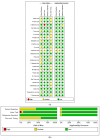A Systematic Review and Meta-Analysis of 29 Studies Predicting Diagnostic Accuracy of CT, MRI, PET, and USG in Detecting Extracapsular Spread in Head and Neck Cancers
- PMID: 38672539
- PMCID: PMC11047869
- DOI: 10.3390/cancers16081457
A Systematic Review and Meta-Analysis of 29 Studies Predicting Diagnostic Accuracy of CT, MRI, PET, and USG in Detecting Extracapsular Spread in Head and Neck Cancers
Abstract
Background: Extracapsular spread (ECS) is the extension of cancer cells beyond the lymph node capsule and is a significant prognostic factor in head and neck cancers. This meta-analysis compared the diagnostic accuracy of CT, MRI, PET, and USG in detecting ECS in head and neck cancers.
Methodology: The authors conducted a systematic review and meta-analysis of studies that compared the diagnostic accuracy of CT, MRI, PET, and USG in detecting ECS in head and neck cancers. They included studies that were published between 1990 and December 2023 and that used histopathology as the reference standard for ECS.
Results: The pooled sensitivity and specificity of CT scan were 0.63 (95% CI = 0.53-0.73) and 0.85 (95% CI = 0.74-0.91), respectively. The pooled sensitivity and specificity of MRI were 0.83 (95% CI = 0.71-0.90) and 0.85 (95% CI = 0.73-0.92), respectively. The pooled sensitivity and specificity of PET were 0.80 (95% CI = 0.74-0.85) and 0.93 (95% CI = 0.92-0.94), respectively. The pooled sensitivity and specificity of USG were 0.80 (95% CI = 0.68-0.88) and 0.84 (95% CI = 0.74-0.91), respectively. MRI had significantly higher sensitivity than CT scan (p-0.05). The specificity of CT and MRI was not significantly different (p-0.99). PET scan had the highest specificity among all imaging modalities.
Conclusion: MRI is the most accurate imaging modality for detecting ECS in head and neck cancers. CT scan is a reasonable alternative, but PET scan may be considered when high specificity is required. USG may not add any further benefit in detecting ECS.
Keywords: CT; ECS; MRI; PET; USG; accuracy; head and neck cancer; imaging; neck node; sensitivity; specificity.
Conflict of interest statement
The authors declare no conflicts of interest.
Figures








References
Publication types
LinkOut - more resources
Full Text Sources

